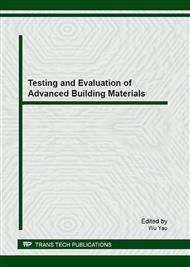p.1
p.5
p.10
p.14
p.19
p.25
p.30
p.35
29Si NMR Characterization of Silica Tetrahedron in the Silica Fume Simulate Hydration
Abstract:
As the major structure of silica fume, the change of silica tetrahedron in the pozzolanic reaction during the hydration has not been revealed clearly in previous studies. In this study, 29Si solid-state MAS NMR was used to characterize the silica tetrahedron change of the silica fume in saturated alkali solution with 0.9, 1.2, 1.5 and 1.8 four different calcium/silica ratios. The amorphous Q4 silica tetrahedron structure in silica fume changed into Q1 silica tetrahedron at 1 day. Q2 silica tetrahedron formed from Q1 silica tetrahedron within 3 days. Q1 and Q2 silica tetrahedron reached a balance until silica fume completed pozzolanic reaction and the Q4 silica tetrahedron exhausted. The coexistence of Q1 and Q2 silica tetrahedron benefited the physical properties increase of cementitious system. 29Si solid-state MAS NMR results proved that the chain length of silica tetrahedron in C-S-H shortened in the silica fume hydration while the C/S ratio increased.
Info:
Periodical:
Pages:
1-4
Citation:
Online since:
January 2013
Authors:
Price:
Сopyright:
© 2013 Trans Tech Publications Ltd. All Rights Reserved
Share:
Citation:


